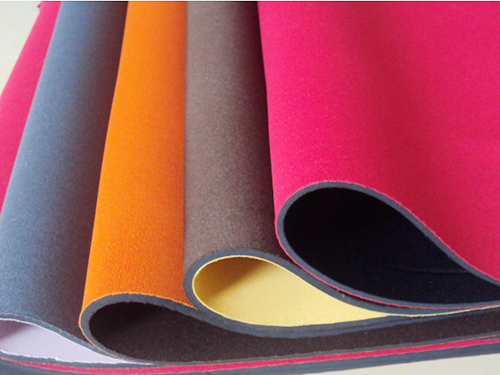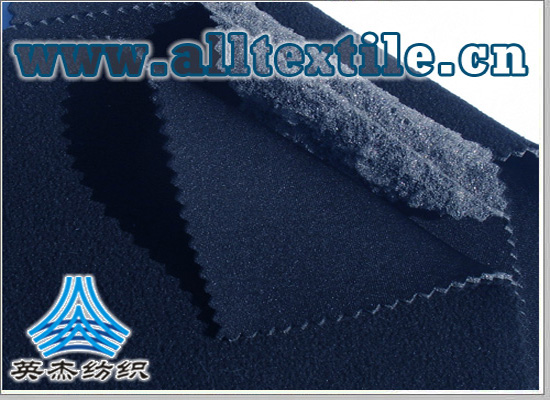Flame-retardant breathable fabric and preparation method thereof Specific implementation mode 2
The technical solutions in the embodiments of the present invention will be clearly and completely described below with reference to the accompanying drawings in the embodiments of the present invention. Obviously, the described embodiments are only some of the embodiments of the present invention, rather than all the embodiments. Based on the embodiments of the present invention, all other embodiments obtained by those of ordinary skill in the art without creative efforts fall within the scope of protection of the present invention.
Example 1

Referring to Figures 1-5, a method for preparing flame-retardant breathable fabrics includes the following steps:
S1: Prepare materials, including: 4 parts modified ramie fiber, 5 parts polyester fiber, 7 parts silk fiber, 5 parts cotton fiber, 5 parts Nomex fiber, 10 parts polyimide 2080 fiber, 5 parts modified glass fiber 10 parts of flame retardant compound, 10 parts of adhesive, 10 parts of antibacterial fiber;
S2: Make flame-retardant fabrics by placing warp Nomex fiber, modified glass fiber and weft polyimide 2080 fiber in a loom for weaving to obtain a heat-insulating flame-retardant fabric;
S3: Apply the material and apply the flame-retardant compound to one side of the flame-retardant fabric woven in S2 to obtain a new heat-insulating flame-retardant fabric;
S4: Make breathable fabrics by placing warp silk fibers, antibacterial fibers and weft cotton fibers in a loom for weaving to obtain silk antibacterial breathable fabrics;
S5: Make a base fabric. Put the warp modified ramie fiber and weft polyester fiber into a loom for weaving to obtain a base fabric. The present invention uses modified ramie fiber with good air permeability as the main fiber to ensure the air permeability of the base fabric. For heat dissipation performance, the shape retention of the base fabric is improved by adding polyester fiber, and the ramie fiber is modified to improve its elasticity, cohesion and spinnability;
S6: Base fabric treatment. The base fabric in S6 is bleached and dyed, wrinkled, and dried in a dryer to obtain the treated base fabric;
S7: Apply adhesive, place the heat-insulating and flame-retardant fabric in S3 and the base fabric in S6 in the rubber roller, and apply the adhesive on the surface of the heat-insulating and flame-retardant fabric and base fabric;
S8: Bonding, with heat-insulating and flame-retardant fabric as the surface layer, silk antibacterial and breathable fabric as the middle layer, and base fabric as the bottom layer. Use an embossing machine to heat-press to obtain flame-retardant and breathable fabric. The surface layer of heat-insulating and flame-retardant fabric and smearing The flame-retardant compound on its surface forms a double flame-retardant protection mechanism, which greatly increases the flame-retardant performance of the fabric. At the same time, the silk antibacterial and breathable fabric is woven from natural cocoon silk and has good breathability, which makes it have good flame retardancy. performance and breathability;
S9: Rolling, the heat-pressed flame-retardant breathable fabric in S8 is air-cooled, trimmed, and rolled.

According to the present invention, the antibacterial fiber in S1 is mixed with an antibacterial agent and a dispersant and a fiber matrix resin, and is melt-spun to obtain an antibacterial fiber. The antibacterial agent includes monohalogenated cyanuric acid, diaminohalogenated alkyl, olefinic halides, and epoxyhalogenated alkyls. , the flame-retardant compound in S1 is mixed with hexafluorobutyl methacrylate, phosphate monomer, aminoolefin compound and graphene oxide, stirs evenly, then heats to 96°C under nitrogen protection, and then adds chloroplatinum acid isopropyl alcohol solution, after 5 hours of reaction, the flame-retardant compound is obtained through treatment. The flame-retardant compound is a linear polymer with a large relative molecular weight, small mobility, excellent flame retardant properties and durability, and the caged phosphoric acid in the flame-retardant compound The ester structure is more likely to be concentrated on the surface of the composite material, forming a dense protective carbon layer to prevent dripping or holes, further improving the flame retardant performance of the flame retardant layer. The raw materials for the preparation of modified glass fiber in S1 include nano-silica , nano alumina, nano calcium oxide, nano zirconia, nano boron oxide, nano iron oxide, nano hydrogen oxide, nano lithium oxide, nano sodium oxide, epoxy resin, toughening agent, the toughening agent is butyl recycled rubber , the modified glass fiber in the present invention improves the shortcomings of traditional glass fiber’s brittleness and poor wear resistance. The finished flame-retardant breathable fabric made of modified glass fiber has excellent flexibility, is comfortable to wear, and improves the resistance To improve the comfort of breathable fabrics, the modified ramie fiber in S1 is to react the etherified ramie fiber in a mixed solution at 50°C for 5 hours, then wash it with water, absolute ethanol, and then wash it with water until it becomes neutral. The modified ramie fiber is obtained , wherein the mixed solution is composed of amino-terminated polysiloxane, sodium bicarbonate and absolute ethanol.
The invention also discloses a flame-retardant breathable fabric, which includes a flame-retardant fabric 2, a silk antibacterial breathable fabric 4 and a base fabric 6. The flame-retardant fabric 2 is provided with a flame-retardant compound 1 on its upper surface, and the flame-retardant compound 1 is evenly distributed. , the flame-retardant fabric 2 includes Nomex fiber, modified glass fiber 8 and polyimide 2080 fiber 9, and the flame-retardant fabric 2 is woven by Nomex fiber 7, modified glass fiber 8 and polyimide 2080 fiber 9, Modified glass fiber improves the shortcomings of traditional glass fiber’s brittleness and poor wear resistance. Glass fiber made of modified glass fiber 8, nano boron oxide, nano iron oxide, nano hydrogen oxide, nano lithium oxide, nano sodium oxide, epoxy resin, toughening agent, the toughening agent is butyl recycled rubber, the modified glass fiber in the present invention improves the traditional Glass fiber has the disadvantages of brittleness and poor wear resistance. The finished flame-retardant breathable fabric made of modified glass fiber has excellent flexibility and comfortable wearing, which improves the comfort of flame-retardant breathable fabric. Modification in S1 Ramie fiber is a modified ramie fiber obtained by placing etherified ramie fiber in a mixed solution at 50°C for 5 hours, washing with water, anhydrous ethanol, and then washing until neutral. The mixed solution is composed of amino-terminated polysiloxane. , sodium bicarbonate and absolute ethanol.
The invention also discloses a flame-retardant breathable fabric, which includes a flame-retardant fabric 2, a silk antibacterial breathable fabric 4 and a base fabric 6. The flame-retardant fabric 2 is provided with a flame-retardant compound 1 on its upper surface, and the flame-retardant compound 1 is evenly distributed. , the flame-retardant fabric 2 includes Nomex fiber 7, modified glass fiber 8 and polyimide 2080 fiber 9, and the flame-retardant fabric 2 is woven by Nomex fiber 7, modified glass fiber 8 and polyimide 2080 fiber 9 , Modified glass fiber improves the shortcomings of traditional glass fiber’s brittleness and poor wear resistance. The finished flame-retardant breathable fabric made of modified glass fiber 8 has excellent flexibility and is comfortable to wear. Silk antibacterial breathable fabric 4 includes Silk fiber 10, antibacterial fiber 11 and cotton fiber 12, and the silk antibacterial breathable fabric 4 is woven by silk fiber 10, antibacterial fiber 11 and cotton fiber 12. The antibacterial fiber 11 has antibacterial and deodorizing properties and prevents the reproduction of bacteria and fungi. It can eliminate odor and keep the skin clean. It can also protect the skin from dryness, prevent itching, and has auxiliary treatment and prevention functions for skin acne, eczema, erythema, and allergic skin. Flame-retardant fabric 2 and silk antibacterial breathable fabric There is a first adhesive 3 between the flame retardant fabric 2 and the silk antibacterial breathable fabric 4 through the first adhesive 3 .
In the present invention, it should be noted that the base fabric 6 includes modified ramie fiber 13 and polyester fiber 14, and the base fabric 6 is woven from the modified ramie fiber 13 and polyester fiber 14. The base fabric 6 and the silk antibacterial and breathable fabric 4 There is a second adhesive 5 between them, and the base fabric 6 and the silk antibacterial breathable fabric 4 are bonded through the second adhesive 5. The modified ramie fiber 13 ensures the breathability and heat dissipation performance of the base fabric. Through the polyester fiber The addition of 14 improves the shape retention of the base fabric and modifies the ramie fiber to improve its elasticity, cohesion and spinnability.
Working principle: Antibacterial fiber 11 has antibacterial and deodorizing properties, prevents the reproduction of bacteria and fungi, eliminates odors, and keeps the skin clean. It can also protect the skin from dryness, prevent pruritus, and treat skin acne, eczema, erythema, It has auxiliary treatment and prevention functions for allergic skin. The modified ramie fiber 13 ensures the breathability and heat dissipation performance of the base fabric. The addition of polyester fiber 14 improves the shape retention of the base fabric, and the ramie fiber is modified to improve the With its elasticity, cohesion and spinnability, modified glass fiber improves the shortcomings of traditional glass fiber’s brittleness and poor wear resistance. The finished flame-retardant breathable fabric made of modified glass fiber 8 has excellent flexibility. It is comfortable to wear and improves the comfort of flame-retardant and breathable fabrics.
In the description in this article, it should be noted that relational terms such as first and second are only used to distinguish one entity or operation from another entity or operation, and do not necessarily require or imply that these entities or any such actual relationship or sequence between operations. Furthermore, the terms “comprises,” “comprises,” or any other variations thereof are intended to cover a non-exclusive inclusion such that a process, method, article, or apparatus that includes a list of elements includes not only those elements, but also those not expressly listed other elements, or elements inherent to the process, method, article or equipment.








